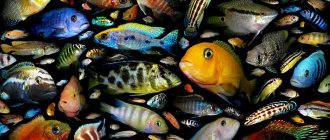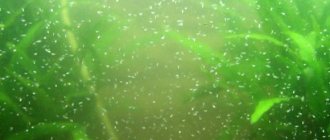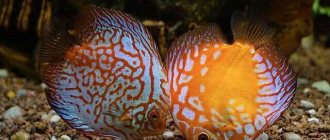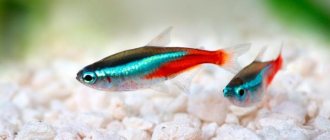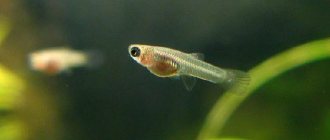Nutrition of cichlids in their natural environment
The nutrition of aquarium fish depends on their food preferences. Food for cichlids is chosen in accordance with what a particular species eats in nature. If you do not maintain the proportions of plant and protein components, problems with the digestive tract and more tragic consequences are possible.
Belonging to a food specialization is determined by the natural habitat and species of fish. Popular cichlids from Lake Malawi, like the freshwater Tanganyika ones, are vegetarians, feeding on single-celled algae, bacteria, detritus, and phytoplankton.
Cichlids of Lake Malawi.
But this does not mean that their daily menu is not diluted with animal food. The protein deficiency is compensated by copepods (small crustaceans), copepods, and snails.
Cichlazomas, acara, etroplus from Asia and most African cyclids are carnivorous . The main diet consists of cyclops, zooplankton (larvae of crabs, shrimp, insects), and daphnia.
Ichthyologists also distinguish the following groups of cichlids:
- omnivores, feeding on plant and protein foods;
- detritivores, whose main “dish” on the menu is detritus (organic debris, sediment);
- parasites whose feeding habits extend to fish scales;
- predators that prefer to eat eggs, fish larvae, fry and smaller fish.
Cichlids are herbivores that feed on algae in rocky fouling, have a digestive tract 2–10 times longer than the body, and sharp teeth for scraping off algae. Parasitic fish have teeth shaped like hooks. The habits of predators are similar to those of pike. They stalk prey from ambush.
Kinds
The cichlid family is divided into two groups:
- South American;
- African.
Differences appear in the conditions of detention and natural habitats. The former need soft water, the latter – medium and high hardness. Both groups have spectacular and colorful fish.
In the aquarium hobby, artificially bred and natural varieties are popular.
Apistograms
South American cichlids with a horizontal stripe running through the body of the fish. The trait is less pronounced in different species. Conventionally peaceful apistograms reach an average of 5–7 cm in length. Popular species: Ramirezi's Apistogramma, Cockatoo, Two-striped, Panda and Hongslo.
Astronotuses
Predatory fish Astronotus also come from Cichlids. Most 35cm water buffalos are raised in aquarium conditions.
Cichlazomas
Slender fish with a pointed muzzle. Body sizes range from 10–17 cm. Popular species: Cichlazoma Flamingo, Black-striped, Meeki, Festivum, Peaceful and Yellow. The color is spotted and striped.
Akary
Large representatives of cichlids. There are peaceful and overly aggressive fish. They have an interesting spotted color and pointed fins, for example, the turquoise acara.
Discus
The disc-shaped body shape and various colors with bright splashes make the fish special and recognizable. Graceful discus fish reach a length of 25 cm.
Angelfish
Along with discus, they are common majestic fish with a body of 15 cm. The leaf-shaped shape and long thread-like fins provide angelfish with attention and adoration.
Geophagus
Cichlids native to South America. They like to sift the soil in search of bottom microorganisms and plant particles. They reach 20 cm in length, have a massive body and a relatively large mouth.
What to feed cichlids in an aquarium?
Food of animal and plant origin is required by vegetarians and predatory cichlids. Carnivores obtain vitamins from plant food. Herbivores vitally need proteins, which are often insufficient in algae and phytoplankton. The ratio of these nutritional components changes with age and depends on the breeding periods.
For herbivorous species of cichlids, feeding based on spirulina is suitable; detritivorous breeds will be satisfied with a large amount of ballast substances. Carnivorous pets prefer live, frozen and dry food with a high protein content of animal origin. Omnivorous fish can be fed with universal formulations.
Aquarists purchase basic food for every day and additional food that replenishes the missing elements. It is given to cichlids a couple of times a week. The main food is chosen taking into account the balance of nutrients, safety for health, and food specialization.
A properly formulated diet for cichlids is determined by the consistency and color of feces. The waste products are dense and dark, which means that nothing threatens the health of the fish. It is worth choosing a different, more balanced diet for light, thread-like excrement.
Cheap food contains few nutrients and is poorly balanced, so it’s not worth saving on your pets.
Frozen food
Deep freezing preserves nutrients. When packaging, blisters with contents are divided into small squares. To prepare the food for use, you do not have to defrost the entire package.
17:54
FROZEN FISH FOOD! REVIEW! FEEDING!
04:11
How to properly feed frozen fish food a mixture of bloodworms, coretra feeding aquarium fish
08:30
Feeding fish in an aquarium, what and how
Cichlids readily eat the following types of frozen foods:
- Cyclops is a copepod rich in carotenoids and amino acids;
- Artemia is a branchial crustacean that brightens the color of fish;
- Gammarus is an amphipod crustacean that normalizes digestion;
- Streptocephalus is a freshwater relative of Artemia;
- Daphnia belongs to the genus Cladocera and lives in stagnant bodies of water.
Frozen bloodworms are fed to predators and omnivorous fish. Malawian cichlids of the Mbuna order are given this type of highly nutritious food in limited quantities to prevent obesity.
Alive
Despite the benefits of dry food, none of them can equally replace live food. Moving daphnia, cyclops, and brine shrimp are well eaten by predators accustomed to hunting. Live crustaceans are beneficial for the fry. With them, growing cichlids develop better, receiving natural nutrition rich in vitamins.
Bloodworms, coretra, and tubifex are used to feed pets. You should not get carried away with worms to avoid problems with digestion.
Homemade
Some aquarists prefer homemade minced meat to ready-made food. Each of them, most often, has its own proven recipe. Here are the most popular ones:
- Grind in a meat grinder 0.5 kg of beef heart, 100 g each of cod, squid, shrimp, 50 g each of liver, cyclops. The minced meat is mixed, 20 g of spinach, parsley, and green salad are added to it. A multivitamin complex in a volume of 10 ml and 50 ml of carrot juice are added to the mixture.
- 500 g of pollock, 100 g of squid, shrimp, nettle leaves scalded with boiling water, and 200 g of green peas are passed through a meat grinder. Add 100 g of low-fat cottage cheese, a finely chopped boiled egg, and 10 ml of multivitamins to the mass.
Signs of an unhealthy diet
You can quickly understand that fish food is not suitable by observing their secretions. If their excrement is dark in color (from black to red depending on the species), then the diet is selected correctly.
If the fish’s discharge is light in color, it means that their digestive system is not working properly, and it is worth reviewing their diet (and, possibly, taking therapeutic and preventive measures).
In case of underfeeding, cichlids gradually develop the following symptoms:
- lethargy;
- exhaustion;
- sunken belly, back and sides;
- desire for solitude.
Overfeeding usually manifests itself as:
- decreased mobility;
- roundness and convexity of the belly and sides.
In the next video you can learn about the diet of Malawian cichlids, as well as watch them feed.
We are considering the option of predatory cichlids.
Dry food of different brands - advantages and disadvantages
Dry food is most often used as the main food for cichlids. Advantages of flakes, granules, sticks over other types of feed:
- quickly absorbed;
- reduce the risk of introducing infection into the aquarium;
- are stored for a long time;
- balanced in nutrient content;
- pollutes less water.
The disadvantages of dry food include disruption of the digestive system when overfeeding pets.
Experienced aquarists recommend purchasing flakes, granules, and sticks for cichlids of various sizes and food specializations of the brands JBL, SERA, Tetra, Tropical.
Sticks
Sticks intended for feeding large fish remain on the surface for a long time and do not become limp. Cichlids have time to eat them even before sinking to the bottom, so the aquarium does not become dirty for a long time.
The product contains animal proteins, fats, plant extracts, vitamins, and microelements. The food is suitable for carnivorous and omnivorous cichlids.
Pros of sticks:
- economical consumption;
- acceptable price;
- convenient way of feeding.
The only downside is that it’s easy to overfeed your pets. The best foods: JBL NovoStick XL, Sera Cichlids Sticks Nature, TROPIKAL Cichlid Sticks.
Granules
Manufacturers make granular food that floats and sinks, green for vegetarians, red for carnivorous cichlids. The dense consistency prevents rapid wetting, and uneaten remains are easy to remove from the aquarium.
The disadvantage is that it increases in size when exposed to moisture. If the dosage of feeding is not observed, the cichlids' belly swells and the anus becomes inflamed. To avoid such problems, the product is pre-soaked and alternated with frozen and live food.
Tetra Cichlid Color Mini Pellets for small cichlids, universal food sera Granulate Menu, Tetra Cichlid Color Pellets for omnivores, sera granugreen nature for herbivorous pets are in demand among aquarists.
Flakes
They consist of components that fully cover the needs of cichlids for amino acids, fats, and fiber. Contains algae, fish products, cereals, shellfish, vegetable protein, oil.
Pros of cereal:
- easy to digest;
- replenish energy potential;
- contain vitamin supplements that strengthen immune defense.
The main disadvantage is that it gets wet quickly and decomposes.
Brittle flakes contain gelatin and gluten. When food gets into the aquarium, it quickly disintegrates, settles to the bottom, and pollutes the water.
For carnivorous cichlids, manufacturers produce red flakes that contain meat. Yellow ones for omnivores contain both fish products and vegetables. Green spirulina determines the color of the flakes for herbivorous breeds.
Popular dry food in the form of flakes: Sera San Nature, Sera Vipan Nature, Tetra Cichlid XL Flocken, Tetra Cichlid XL.
Care for Lake Malawi cichlids and features of their maintenance
Being relatives, these fish still differ in their keeping conditions; they require different conditions. True, they all need a lot of space to swim. The general ratio of fish and aquarium capacity should be as follows:
- 100-150 l - 2 inhabitants:
- 150-200 l - 3;
- 250-300 l - no more than 6:
- 300-400 l - no more than 8;
- 400 l and above - from 10 fish.
Herbivorous mbunas in nature search for food, actively moving along the bottom. That is why for them the aquarium bottom should be planted with a variety of algae. Also, males are quite aggressive towards other fish species, so they are kept separately. Only aquarium snails are suitable as neighbors; they will also act as a kind of water filter. It is also undesirable to keep several males together - they will maim each other with their sharp teeth. If the fish is injured, it must be removed immediately.
We recommend reading Golden Catfish Corydoras
Predatory utaka cichlids will prefer a bottom covered with various sizes of sea pebbles. Snags and stones are required, behind which they like to hide when hunting for prey. In order for ducks to fully receive animal food rich in proteins, fish of other species - both fry and adults - must be periodically released into their aquarium.
Feeding schedule
If you are guided by their lifestyle in their natural environment, cichlids should be fed in small portions from dawn to dusk. This is unrealistic.
The fry require more energy to grow. They eat three times a day, maximum 4 times. Adult cichlids are satisfied with two meals a day. The first feeding is in the morning, no later than an hour after the start of daylight, the second in the evening, 2 hours before turning off the lights. Vegetarians need to be fed more often , since after consuming a single portion, nutrients are enough to maintain vital functions for 4–5 hours.
It is not enough to develop a feeding regimen; you need to experimentally select the dosage for cichlids. The optimal portion is considered to be one that is eaten within 5–8 minutes. If granules or flakes remain after feeding, they are removed from the aquarium and the amount of food is reduced. It is necessary to remove residues from the water in order to prevent rotting and to prevent an increase in the concentration of nitrogen compounds.
It should be taken into account that a cichlid may refuse to feed when carrying fry in its mouth, illness, new food, or stress due to a change in water.
To understand whether the pet receives enough nutrients from food, their appearance is assessed. When there is a shortage of food, the cichlid becomes inactive, lethargic, with a retracted abdomen, sagging back and sides. If the roundness of the abdomen and sides does not subside even after a one-day fast, the fish has developed obesity.
Fasting days are needed only for those cichlids that are fed without following the dosage. Complete refusal of food one day a week is beneficial for obesity, undesirable for juveniles and deadly for fry. Fasting days are contraindicated for cichlids with long intestines. This path leads to spironucleosis, an incurable fish tuberculosis.
Spreading
- Labidochromis caeruleus var. "Yellow" refers to endemics of the large African lake Malawi. This species belongs to the Mbuna group. Its representatives feed mainly on plant foods and may exhibit more aggressive behavior compared to their carnivorous neighbors from the Utaka group. Specifically, in yellow labidochromis, aggression manifests itself closer to spawning.
- Mbuna roughly translates to “rock-dwelling fish” in local languages. Labidochromis caeruleus var. Yellow also prefers to live near rocky shores. This feature must be taken into account when designing an aquarium.
One of the most popular aquarium favorites are Malawian cichlids, which belong to the Cichlid family. They ended up in a lake called Malawi about 1 million years ago, having got there from Lake Tanganyika. The reservoirs are connected by a river channel, which was formed by tectonic shifts. Further, thanks to a phenomenon unique to evolution, which no longer has analogues in the world of fauna, a single form of fish developed into 5 hundred varieties.
Content
How and what to feed the fry?
Starter food for fry of cichlids - brine shrimp, nematodes. After two weeks, juveniles of carnivorous and omnivorous species are given chopped tubifex, and later - cut bloodworms. Egg yolk is used as an additional feeding.
03:04
Cichlids what to feed fry
02:14
Cichlid fry. Food for cichlid fry.
07:28
What to feed the fry? Starter feed for fry of spawning fish.
Grown-up fry eat flakes and granules crushed into dust well.
There are certain requirements for food for juvenile cichlids:
- live food must be mobile and safe;
- dry - not sticky, pre-soaked;
- Freezing is given immediately after defrosting or no later than a day of storage in the refrigerator.
If there is any doubt about the freshness of the product, it is rejected.
Compatibility
The most peaceful of aquarium cichlids are considered to be discus, angelfish, pelvicachromis, apistogramma and representatives of other “dwarf” species. They get along well with shrimp and small, moderately active fish, such as tetras, minors or neons.
Some large species are also considered relatively calm aquarium cichlids, in particular the black-striped cichlid, yellow cichlid or lemon labidochromis.
Typically, cichlids are only interested in those fish that can become prey for them. Therefore, it is better to add large individuals that are not considered as food items as neighbors. The shark barb will be a good neighbor for large and medium-sized aquarium cichlids.
Important! It is strictly forbidden to introduce small fish, such as neons, into an aquarium with large cichlids. They will become easy prey for predators.
Mistakes when feeding cichlids!
Possible errors when preparing a diet, choosing a dosage, diet:
- Some novice aquarists believe that feeding cichlids with granules, flakes, and sticks of different compositions from different manufacturers is a misconception. It is advisable to introduce additional nutrition into the pet’s diet - frozen, live or homemade food, vitamin supplements.
- A common mistake is a violation of the diet. If you do not adhere to feeding at set hours, the gastric juice will not contain the necessary enzymes, and the food will not be fully absorbed.
- Those who like to pamper their cichlids with an additional portion of food risk the health and life of their pets. Obesity leads to failure of the functions of all internal organs, irreversible metabolic disorders, and death.
Feeding cichlids is an important part of caring for aquarium fish. If you choose high-quality balanced food, do not give food from the table, stick to the diet and do not overfeed, cichlids will delight their owners for up to 10 years.
African species
Most of the cichlids live on the African continent. The main habitats of these fish are some of the largest lakes in the world - Malawi, Tanganyika, Victoria, as well as other lesser known ones. In addition to lake species, there are also river species. The appearance of African cichlids is very diverse.
Most have an elongated, slightly flattened body. The fins of males are long, with sharp edges, while those of females are more rounded.
Some species have a growth on the head or a slightly elongated mouth.
Most species have spectacular, bright colors, which help to distinguish relatives from representatives of other species.
- Pelvikachromis pulcher or parrot cichlid has an elongated, slightly flattened body of yellow-brown color with a scarlet spot on the belly and small bright dots on the fins. In an excited state or during spawning, the color becomes more saturated. Parrots grow relatively small, males - about 10 cm, and females - up to 7 cm. The average life expectancy is approximately 5 years. It has a rather peaceful character.
- Hemichromis aureus is an inhabitant of ponds and rivers in western Africa. The body of the fish is elongated and flattened on the sides, the head has a high forehead and thick lips. The color is yellow-green, the belly is yellowish or faint red. There are 5 dark spots on the sides and gills. During spawning, the color of the fish becomes golden in color, and the abdomen becomes scarlet. On average they live up to 10 years, the maximum length becomes 15 cm.
- Hemichromis red is similar in description to the previous representative of cichlids, but differs in color. The fish has a bright red body with numerous bluish dots; they are even present on the fins. Males are slightly larger in size, and as they mature, they develop a growth on their head. Females have a lighter color and fewer spots. On average they grow up to 10 cm.
- Haplochromis cornflower is an inhabitant of Lake Malawi. It is distinguished by its unusual blue color. The lower fin of the fish is yellowish in color, the dorsal fin is different in length, and on it, like on the tail, there are several small yellow spots. Adults reach 20 cm, both males and females.
- Due to its rather scattered habitats, Haplochromis philander The largest representatives (about 11 cm) have a yellowish-green color with a golden tint, but the back and sides have a light blue tint, the body is covered with blurry stripes, turning into spots in the tail. Fish with smaller sizes (8 cm) are distinguished by a yellowish-olive color (males) and a clay-yellow color (females). The fins have small greenish dots, and the male has a bright red spot near the anal fin.
Males of the smallest representatives of the philander from Southeast Africa (up to 8 cm) have the same color as their medium-sized relatives, only with a pronounced blue tint; females are also similar.
- Frontosa is an inhabitant of the sandy bottom of Tanganyika. The body of the fish is long, with flattened sides and a high back; a characteristic growth appears on the head of adult individuals. The body color of the frontosa can vary from grayish-white to gray-blue; on the sides there are six transverse stripes of different widths of a dark tone. This type of fish is distinguished by its phlegmatic character and inactivity.
- Tropheus stellate is distinguished by a slightly elongated, arched body. The main color is black and blue, on the sides between the fins - the ventral and the beginning of the dorsal - there is a yellow, rather wide stripe located across. The fins are dark in color with black-blue edges and dots of a pale yellow hue. Can grow up to 12 cm.
- Pseudotropheus Pindani has an elongated body of a soft blue color, sometimes with a slight purple tint. The fins have dark blue rays. There are several yellow spots on the anal fin of males. Males are larger than females, but their colors are the same.
- Pseudotropheus zebra is distinguished by an elongated, slightly laterally compressed body and a fatty formation on the head. The species is characterized by an extraordinary color palette - about 50 color options: white, blue, red, yellow, orange. There are 7-9 transverse darker stripes on the sides.
- Pseudotropheus lombardo has a yellow-golden or yellow-brown color; in some cases, not very clear stripes are noticeable on the sides. The fins have a light blue tone, the anal fins are decorated with yellow dots, and the dorsal fins have a white edge. The fish reach 15 cm in length.
- Lamprologus are represented by several species, a characteristic feature common to all of them is an elongated body, but the colors are completely different. Lamprologus blue has an elongated body of a bluish tone with five black stripes across the sides; there is also a line of the same color on the forehead. Because of its color, it is also called the five-striped zebra. The length of males is about 15 cm, females have smaller parameters.
- Lamprologus ribbon shell can have several colors: blue, brown, yellowish or creamy orange; there are 9 thin silver stripes on the body.
- Lamprologus orange is distinguished by three color options: orange, golden yellow or blackish with numerous light spots.
- Lamprologus ocellata has a light brown body, on which 3 rows of shiny scales are placed in a longitudinal order.
- Labidochromis yellow, also called lemon or hummingbird, belongs to the dwarf species of cichlids. Individuals of both sexes have a yellow color; in the dominant males it is more saturated, and, in addition, their fins are black, with a yellow edging on the back. Females have yellow fins.
- The golden leopard has a flattened body and a high back. The main background is whitish-yellow, the whole body is covered with large spots of olive green and black stripes. The dorsal fin has a golden edge, and the caudal fin is yellowish-orange. When the male becomes sexually mature, his color changes completely, spots and stripes disappear, and his head and belly acquire a blue tint. The body becomes more yellow with slightly noticeable, blurred small spots.
- Melanochromis golden auratus has different color options for individuals of different sexes. Males have a brownish-black body and a golden back; on the sides there are 2 parallel blue horizontal stripes along the entire body. The fins are white-yellow or blue, with 1-2 light dots located on the anal fin.
The color of females is golden yellow with brown stripes. The yellow fins also have brownish lines, and the tail is decorated with black spots.
- The blue dolphin has a rather tall, slightly compacted body and a large head with a characteristic convex forehead (in adult males) and thick lips. Young representatives of the dolphin are characterized by a gray-blue color with a slight silvery sheen and dark stripes on the sides. In adult fish, the color of the fins and body is velvety blue. During spawning, the bulge on the male's forehead turns yellow.
- Aulonocara Benshi is characterized by a strongly flattened body of an elongated shape. The male’s forehead and body are yellow, but the mouth, cheeks and gills are purple, with 7-9 purple stripes located vertically on the sides. The female has a dark brown color with 8-9 dark stripes. Aulonocara grow up to 12 cm in length.
- The red kadango has a large head and mouth, with which it swallows large portions of water with plankton. In different parts of Lake Malawi, there are several varieties of kadango, which differ in color. Representatives of the Kadango with a bluish head and a yellowish or red body are popular as aquarium fish. Some fish have 3 black spots on both sides. Females are smaller and predominantly grayish in color.
- Maingano is also a dwarf cichlid species with an elongated body and a rounded head. There is a low fin along the entire back. The color of the fish is dark blue with two stripes located horizontally and having a blue color. The edges of the fins and tail are bordered by a thin bluish stripe.
Common diseases of aquarium inhabitants
Diseases are not very common among Malawian cichlids. Fish are hardy and not sensitive to parasites and pathogens, but if the necessary conditions are not met, some problems cannot be avoided.
To prevent the development of pathogenic organisms in the aquarium, use methylene blue, malachite green and sidex.
If the water in which a group of cichlids lives is of unsuitable quality, the fish will develop ascites, or dropsy. The disease is expressed in decreased appetite, discoloration and protruding scales. After a few days the cichlid dies.
Another ailment is an inflammatory process in the swim bladder: a sick fish swims on its side or upside down. This can happen due to some kind of infection, a fight between males, or improper transportation of cichlids.
Cichlids can get sick with oodiniosis, argulosis, and lerneosis. Also dangerous are fin rot, bulging eyes, ichthyophthyriasis, malawi bloat and hexamitosis. In addition, fish may develop intestinal parasites.
Fish that begin to look bad or are already clearly ill, as well as “new ones,” are kept in quarantine for some time.
This is brief information about Malawian cichlids, which have a complex character and memorable appearance. If you have any additional facts or tips to share, please leave a comment on the article. Share it with your friends and like it if the material was useful.
Aquarium cichlids are common, intelligent fish, characterized by enormous species diversity and interesting behavior. On average, fish live 10 years, among them there are species that can live 15–20.
Proper design will highlight beauty
For Malawian cichlids, you need to place a dim lamp in the aquarium (for illumination and for partial heating), a filter, an aerator and a temperature regulator. Periodic replacement of vegetation on the bottom is required, and rotting and diseased algae must also be removed so that the fish do not get sick or get poisoned. Regular cleaning is required. You should change 30% of the liquid weekly, after allowing it to settle.
Both types of Malawian cichlids will look very advantageous against the background of interesting scenery, which include:
- large colored stones;
- large driftwood branches;
- chest-shaped sea shells;
- a small plastic house with windows and a door that open.
Today, any specialized store will delight you with a huge assortment of aquarium accessories and decorations. Artificial decorations must be cleaned and washed promptly to prevent the formation of mold that is harmful to fish. By frequently changing the water in the aquarium, you will avoid widespread diseases of cichlids.
The water parameters should be as follows: temperature - from 23 to 26 degrees Celsius, hardness - 4-8, pH - from 7.7 to 8.5.
